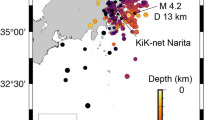Abstract
Site response in the aftershock zone of 2001 Bhuj M w 7.7 earthquake has been studied using the H/V spectral ratio method using 454 aftershocks (M w 2.5–4.7) recorded at twelve three-component digital strong motion and eight three-component digital seismograph sites. The mean amplification factor obtained for soft sediment sites (Quaternary/Tertiary) varies from 0.75–6.03 times for 1–3 Hz and 0.49–3.27 times for 3–10 Hz. The mean amplification factors obtained for hard sediment sites (hard Jurassic/Mesozoic sediments) range from 0.32–3.24 times for 1–3 Hz and 0.37–2.18 times for 310 Hz. The upper bounds of the larger mean amplification factors for 1–3 Hz are found to be of the order of 3.13–6.03 at Chopadwa, Vadawa, Kavada, Vondh, Adhoi, Jahwarnagar and Gadhada, whereas, the upper bounds of the higher mean amplification factors at 3–10 Hz are estimated to be of the order of 2.00–3.27° at Tapar, Chopadwa, Adhoi, Jahwarnagar, Gandhidham and Khingarpur. The site response estimated at Bhuj suggests a typical hard-rock site behavior. Preliminary site response maps for 1–3 Hz and 310 Hz frequency ranges have been prepared for the area extending from 23–23.85 °N and 69.65–70.85°E. These frequency ranges are considered on the basis of the fact that the natural frequencies of multi-story buildings (3 to 10 floor) range between 1–3 Hz, while the natural frequencies for 1 to 3 story buildings vary from 3–10 Hz. The 1–3 Hz map delineates two distinct zones of maximum site amplification (>3 times): one lying in the NW quadrant of the study area covering Jahwarnagar, Kavada and Gadadha and the other in the SE quadrant of the study area with a peak of 6.03 at Chopadwa covering an area of 70 km × 50 km. While the 3–10 Hz map shows more than 2 times site amplification value over the entire study area except, NE quadrant, two patches in the southwest corner covering Bhuj and Anjar, and one patch at the center covering Vondh, Manfara and Sikara. The zones for large site amplification values (∼3 times) are found at Tapar, Chopadwa, Adhoi and Chobari. The estimated site response values show a good correlation with the distribution of geological formations as well as observed ground deformation in the epicentral zone.
Similar content being viewed by others
Author information
Authors and Affiliations
Rights and permissions
About this article
Cite this article
Mandal, P., Chadha, R.K., Satyamurty, C. et al. Estimation of Site Response in Kachchh, Gujarat, India, Region Using H/V Spectral Ratios of Aftershocks of the 2001 M w 7.7 Bhuj Earthquake. Pure appl. geophys. 162, 2479–2504 (2005). https://doi.org/10.1007/s00024-005-2784-6
Received:
Accepted:
Published:
Issue Date:
DOI: https://doi.org/10.1007/s00024-005-2784-6




